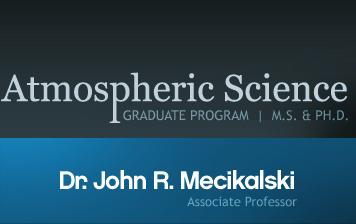Satellite-based Convective Storm & Convective Initiation Studies
Convective Momentum Flux Diagnosis Research
 Background:
Background:
Research and case studies have shown that convection plays a large role in large-scale environmental circulations. Convective momentum fluxes (CMFs) have been studied for many years using in-situ and aircraft measurements, along with numerical simulations. However, despite these successes, little work has been conducted on methods that use satellite remote sensing as a tool to diagnose these fluxes. Uses of satellite data, especially NASA assets, have the capability to provide continuous analysis across regions void of ground based remote sensing.
The objective of this study is to develop a synergistic approach to retrieving CMFs over the footprint of all NASA instruments, namely ~35 N to ~35 S, for selected case events, exploiting appropriate NASA satellite platforms. The proposed study will expand on the preliminary research already conducted on GOES and TRMM, and will rely on data observed by CloudSat, as well as on surface winds estimated by QuikScat. CloudSat will provide key storm-structure, draft profile and microphysical (e.g., raindrop size) information necessary to obtain perturbation momentum components (u’, v’ and w’).
Flux retrievals will be performed at native sensor resolutions, and be integrated up to regional-scale momentum (flux) budgets, which in turn will be validated against high-resolution (1 km) cloud-resolving model (CRM) simulations of explicitly resolved convective storms in the tropics. With sound research already conducted using GOES satellite-derived winds showing success compared to CRMs, the proposed elements of this study are viable, setting forth in the NASA Earth Sciences Division objectives for understanding the earth-atmosphere system.
Main Results
Convective momentum transport (CMT) has been studied frequently using in-situ and aircraft measurements. Prior to our research, little work had been conducted on using satellite remote sensing as a tool to diagnose these transports in a convective regime. Using a series of NOAA and NASA instruments, convective momentum fluxes have been estimated for a variety of convective regions. The instruments include the Geostationary Operational Environmental Satellites (GOES), the Tropical Rainfall Measuring Mission (TRMM), the Quick Scatterometer (QuikScat), and CloudSat Precipitation Radar (CPR).
- GOES – Using mesoscale atmospheric motion vectors as described by Bedka and Mecikalski (2005) as a measure of horizontal motion and cloud top cooling rates to estimate vertical velocities, the convective momentum fluxes (CMFs) produced were comparable in sign and magnitude to those of a cloud resolving model.
- TRMM – To use TRMM as a tool to diagnose CMFs, it is assumed that updraft tilts provide information about the air motions occurring in and around their environment. TRMM offers a three-dimensional view of these updrafts through its reflectivity product, and using a climatological estimate of updraft velocity along with a model-derived storm motion vector reveals CMFs that are close in sign and magnitude in the mid- and upper-troposphere, but lacks detail in the lower troposphere due to the climatological lower values of vertical velocity.
- QuikScat – QuikScat is used to provide sub-cloud base estimates of convective momentum fluxes. Using the continuity equation and assuming vertical motion at the surface is zero allows for integrating values of CMFs to cloud base.
- CloudSat – Colorado State University is currently working on developing a three-dimensional swath using a statistical approach between MODIS and CloudSat products. With a 3-D curtain of information, similar methodologies as used with TRMM can be applied to the CloudSat data. The CloudSat produced by CSU would have higher spatial resolution compared to TRMM’s, which could provide even better results.
Momentum can be transported upgradient or downgradient, implying that shear can be enhanced or mixed out within convective regimes. Therefore, it is the goal of this study to develop a multi-sensor algorithm that can retrieve convective momentum fluxes over a wide variety of convective regimes. With this goal in mind, a possible outcome would be validation of different convective parameterizations over varying regimes.

 Background:
Background: